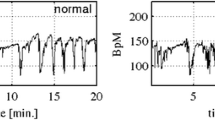Abstract
Electronic Fetal Monitoring (EFM) records fetal heart rate in order to assess fetal well being in labor. Since its suggestion in clinical practise by de Kergeradee in the nineteenth century, it has been adopted as standard medical practise in many delivery scenarios across the globe. The extent of its use has augmented from its original purpose and is now used to not only reduce prenatal mortality, but also neonatal encephalopathy and cerebral palsy. One of the difficulties with EFM is interpreting the data, which is especially difficult if it is acquired in a continuous fashion. A grading system has been developed (utilised for developing a guideline for Clinical Practise Algorithm) which consists of grading fetal heart rate (FHR) into fairly rough categories (three). These categories are defined by values associated with a set of four features. The values for this set of features are potentially influenced by the particular collection equipment and/or operating conditions. These factors, in conjunction with a stressful condition such as a complicated delivery scenario may render rapid and unequivocal reporting of the neonatal status sometimes difficult. This chapter examines the development of automated approaches to classifying FHR into one of three clinically defined categories. The ultimate goal is to produce a reliable automated system that can be deployed in real-time within a clinical setting and can therefore be considered as an adjunctive tool that will provide continuous on-line assistance to medical staff.
Access this chapter
Tax calculation will be finalised at checkout
Purchases are for personal use only
Similar content being viewed by others
References
Alfirevic, Z, Devane, D., Gyte, GML.: Continuous cardiotocography (CTG) as a form of electronic fetal monitoring (EFM) for fetal assessment during labour (Review) 1, Copyright © 2007 The Cochrane Collaboration, Wiley (2007)
Ito, T., Maeda, K., Takahashi, H., Nagata, N., Nakajima, K., Terakawa, N.: Differentiation between physiologic and pathologic sinusoidal FHR pattern by fetal actocardiogram. J. Perinat. Med. 22(1), 39–43 (1994)
American College of Obstetricians and Gynecologists Task force on Neonatal Encephalopathy and Cerebral Palsy. Neonatal Encephalopathy and Cerebral Palsy: Defining the Pathogenesis and Pathophysiology, Jan (2003)
Tsuzaki, T., Sekijima, A., Morishita, K., Takeuchi, Y., Mizuta, M., Minagawa, Y., Nakajima, K., Maeda, K.: Survey on the perinatal variables and the incidence of cerebral palsy for 12 years before and after the application of the fetal monitoring system. Nippon Sanka Fujinka Gakkai Zasshi, 42, 99–105 (1990)
Ayres-de-Campos, D., Bernardes, J., Garrido, A., De Sa, J.P.M., Pereira-Leite, L.: SisPorto 2.0: a program for automated analysis of cardiotocograms. J. Matern. Fetal Med. 9, 311–318 (2000)
Georgoulas, G., Gavrilis, D., Tsoulos, I.G., Stylios, C., Bernardes, J., Groumpos, P.P.: Novel approach for fetal heart rate classification introducing grammatical evolution. Biomed. Signal Process. Control 2, 69–79 (2007)
Warrick, P., Hamilton, E., Macieszczak, M.: Neural network based detection of fetal heart rate patterns. IEEE Trans. Biomed. Eng. 57(4), 771–779 (2010)
Fontenla-Romero, O., Guijarro-Berdinas, B., Alonso-Betanzos, A.: Symbolic neural and neuro-fuzzy approaches to pattern recognition in cardiotocograms. Adv. Comput. Intell. Learn. Int. Ser. Intell. Technol. 18, 489–500 (2002)
Ulbricht, C., Dorffner, G., Lee, A.: Neural networks for recognizing patterns in cardiotocograms. Artif. Intell. Med. 12, 271–284 (1998)
Georgoulas, G., Stylios, C., Groumpos, P.P.: Integrated approach for classification of cardiotocograms based on independent component analysis and neural networks. In: Proceedings of 11th IEEE Mediterranean conference on Control and Automation, 2003, Rodos, Greece, 18–20 June (2003)
Jezewski, M., Wrobel, J., Labaj, P., Leski, J., Henzel, N., Horoba, K., Jezewski, J.: Some practical remarks on neural networks approach to fetal cardiotocograms classification. In: Proceedings of IEEE Engineering in Medicine and Biology Society, pp. 5170–5173 (2007)
Revett, K.: A rough sets based approach to analysing CTG datasets. Int. J. Bioinform. Healthc. (in press)
Komorowski J., Pawlak Z., Polkowski L., Skowron A.: Theory, knowledge engineering and problem solving. Dordrecht: Kluwer, 1991. Rough sets: A Tutorial, In: Pal, S.K., Skowron, A. (eds.) Rough Fuzzy Hybridization: A New Trend in Decision Making, Springer, Singapore, pp. 3–98, (1999)
Acknowledgments
The authors would like to acknowledge the source of the dataset: the UCI KDD data repository, into which this dataset was deposited by faculty members at the University of Porto, Portugal.
The research of Barna Iantovics was supported by the project “Transnational Network for Integrated Management of Postdoctoral Research in Communicating Sciences.” Institutional building (postdoctoral school) and fellowships program (CommScie)-POSDRU/89/1.5/S/63663, Financed under the Sectorial Operational Programme Human Resources Development 2007–2013.
Author information
Authors and Affiliations
Corresponding author
Editor information
Editors and Affiliations
Rights and permissions
Copyright information
© 2014 Springer International Publishing Switzerland
About this chapter
Cite this chapter
Revett, K., Iantovics, B. (2014). A Survey of Electronic Fetal Monitoring: A Computational Perspective. In: Iantovics, B., Kountchev, R. (eds) Advanced Intelligent Computational Technologies and Decision Support Systems. Studies in Computational Intelligence, vol 486. Springer, Cham. https://doi.org/10.1007/978-3-319-00467-9_12
Download citation
DOI: https://doi.org/10.1007/978-3-319-00467-9_12
Published:
Publisher Name: Springer, Cham
Print ISBN: 978-3-319-00466-2
Online ISBN: 978-3-319-00467-9
eBook Packages: EngineeringEngineering (R0)




